At approximately 5:00 p.m. on October 17, 2003, a fire began in a storage closet on the 12th floor of a Cook County Administration Building in Chicago. Since there were no Fire Safety Director personnel at the building, the building engineer decided to evacuate. The Emergency Voice/Alarm Communications (EVAC) system was activated, informing personnel that they should evacuate the building using any set of stairs. The Chicago Fire Department (CFD) was called and began fighting the fire from the southeast stairway on the 12th floor.
Personnel evacuating from above the 12th floor in the southeast stairway were stopped at the 12th floor by firefighters and told to go back. When they did, they found all the doors locked up to the 27th floor. However, before all the evacuees on the stairway could make it up to the 27th floor, the firefighters opened the stairway door to fight the fire. This, combined with a smoke tower system that may not have been functioning correctly, led to the stairway filling with smoke and toxic gases, which overcame several people on the stairs. Six of these people died. The last body was found in the stairway approximately 90 minutes after the fire began.
We can use the information from the report commissioned on the incident to capture the Cook County Administration Building as an example of the Cause Mapping method. The three steps are 1) Define the problem, 2) Conduct the analysis and 3) Identify the best solutions. Each step will be discussed below.
Step 1. Define the Problem
The first step of the Cause Mapping approach is to define the problem by asking the four questions: What is the problem? When did it happen? Where did it happen? And how did it impact the goals? One person may say that the problem was the fire. Another person might say that the problem was that people were trapped in the stairway. We can write both “problems” on the first line. In the Cause Mapping methodology the facilitator anticipates that the group may disagree so all three responses are written down. There is no need to spend time debating the problem. The magnitude of this incident is defined by the impact to the goals.
The second question is the “When?” which is the date and time of the incident. When captures the timing of the issue and also has a line for what was different or unusual in this occurrence. The question of what was different is fundamental in any investigation. On the Cook County Administration Building Fire we capture the date as October 17th, 2003 and the time of 5:00 p.m. when the fire began. An important difference that contributed to this incident were stairway doors that locked automatically.
In an investigation there can be several pieces of information that need to be captured when specifying the location. At a minimum the physical/geographic location and the process should be captured. The physical location is where geographically the incident happened. In this case, the fire began in a storage closet on the 12th floor of the Cook County Administration Building in Chicago, Illinois.
The next section is the impact to the overall goals. Having no fatalitites is always a goal, the safety goal. There were six fatalities as a result of the fire. This is an impact to the safety goal. There were other goals that were affected but the magnitude of the loss of life makes any other goals less significant.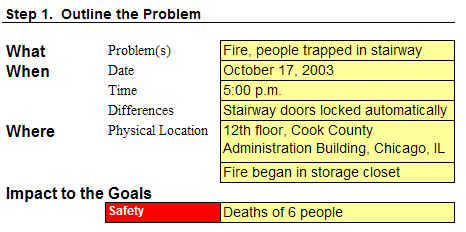
Step 2. Identify the Causes (The Analysis)
The analysis step is where the incident is broken down into causes which are captured on the Cause Map. The Cause Map starts by writing down the goals that were affected as defined in the problem outline. For the fire, the safety goal was impacted because of the six lives that were lost. This is the first cause-and-effect relationship in the analysis.
The analysis can continue by asking Why questions and moving to the right of either of the cause-and-effect relationships above. The next question is “Why did six people die?” They died from smoke inhalation, caused by being trapped in a stairway which was overcome by smoke and toxic fumes and not discovered for approximately 90 minutes. We’ll look at each of these causes in turn.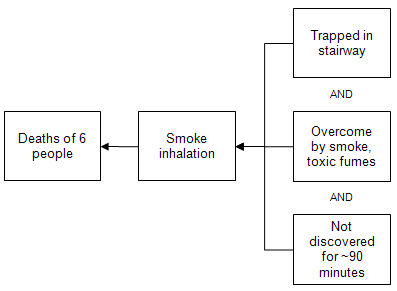
People were trapped in the stairway because they were told to evacuate by all stairs, and the people in the Southeast stairway were unable to exit. On the Southeast stairway, firefighters were blocking the stairway at the 12th floor, evacuees went back up the stairs, and the doors above the 12th floor were locked until the 27th floor.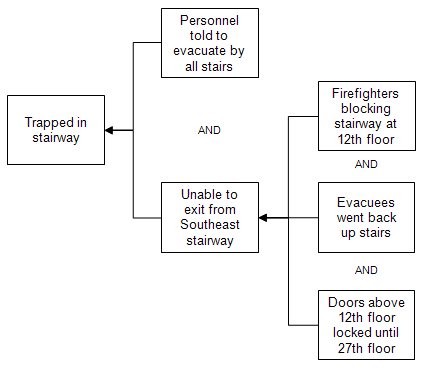
Firefighters were blocking the stairway at the 12th floor because of an uncontrolled fire on the 12th floor. The fire began in a storage closet; how it started it unclear. The firefighters had difficulty extinguishing the fire because the building had no sprinkler system.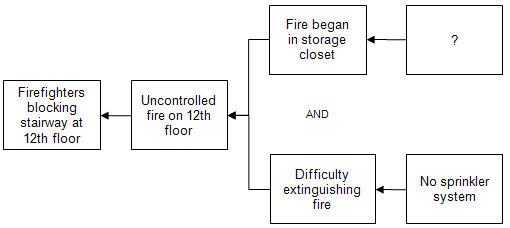
Evacuees went back up the stairs because they were unaware that the stair doors would be locked, due to a lack of evacuation instructions and guidance, and because they were instructed to go back up by firefighters, who were engaging in firefighting operations (as discussed above) and prioritized firefighting operations over lifesaving, according to the commissioned report.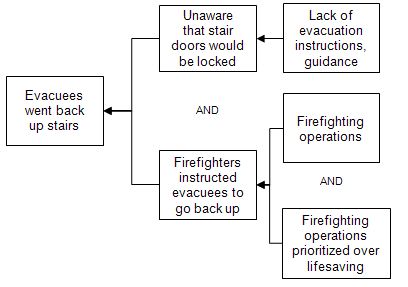
The people in the stairway were overcome by smoke and toxic fumes because the stairway was filled with smoke and fumes. Smoke from the fire was released into the stairway (we’ll talk about this more) and there was no ventilation provided by the Chicago Fire Department (CFD) for unknown reasons.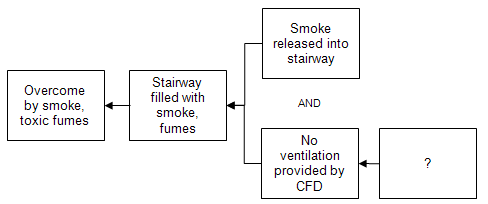
Smoke was released into the stairway due to structural flaws (that were a code violation), and nonoperable louvers, due to lack of periodic testing and maintenance. Both these causes contributed to the not proper functioning of the smoke removal system, which should have diverted the smoke out of populated spaces. Additionally, the doors separating the stairway from the smoke tower were breached by the fire department, who did not search or clear the area before opening the doors, as recommended.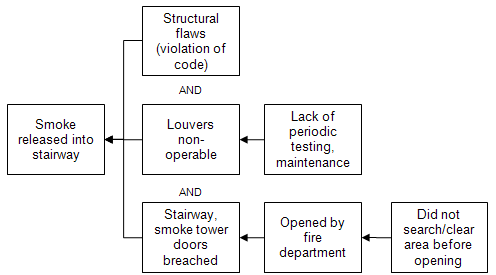
The people trapped in the stairway were not discovered for approximately 90 minutes, due to lack of guidance from the incident commander thanks to an improperly staffed command post. There was no stairway search before or during firefighting operations, which would have found the people trapped there. Additionally, even after multiple 9-1-1 calls regarding people trapped in the stairways there were no adequate searches. This is believed to be because firefighting operations were prioritized over lifesaving, as discussed above, and due to miscommunications between the call center and the scene.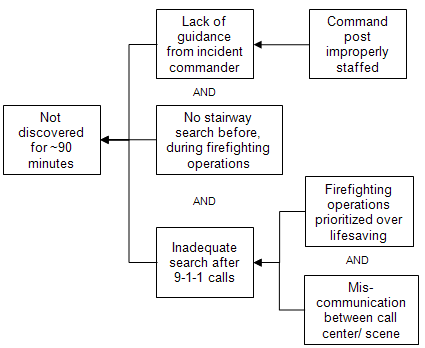
Even more detail can be added to this Cause Map as the analysis continues. As with any investigation the level of detail in the analysis is based on the impact of the incident on the organization’s overall goals.
Step 3. Select the Best Solutions (Reduce the Risk)
Once the Cause Map is built to a sufficient level of detail based on the impact to the goals, solutions can be brainstormed based on the causes on the map. An issue should be worked to a sufficient level of detail to prevent the incident, meaning to reduce the risk of the incident occurring to an acceptable level. This is why solutions and work processes at a coffee shop are not as thorough or detailed as an airline or nuclear power facility. The risk or impact to the goals dictates how effective the solutions should be. Lower risk incidents will have relatively lower detail investigations while significantly high risk to an organization’s goals requires a much more thorough analysis. Solutions are placed on the Cause Map directly above the causes they control.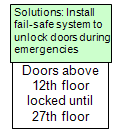
Once possible solutions have been determined, solutions are selected based on the needs of the organization. Once the solutions are selected, they are placed in an action items table. The causes and associated solutions are listed in an actions item table, complete with due dates and positions of people responsible to ensure accountability.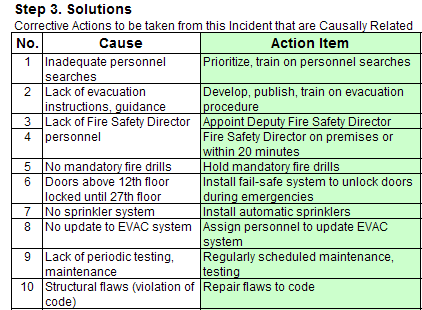
There are causes to every issue. The Cook County Administration Building fire tragedy at a high level has only one cause. At a more detailed level it has 16 causes, 32 causes and 65 causes. All of the levels of the Cause Map are accurate – some simply have more detail that others.
Shown below is the CookCountyFire Cause Map with 65 causes, evidence and solutions.
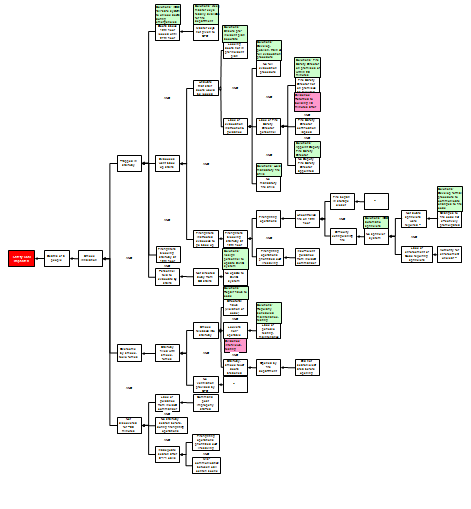
Cause Mapping Improves Problem Solving Skills
The Cause Mapping method focuses on the basics of the cause-and-effect principle so that it can be applied consistently to day-to-day issues as well as catastrophic, high risk issues. The steps of Cause Mapping are the same, but the level of detail is different. Focusing on the basics of the cause-and-effect principle make the Cause Mapping approach to root cause analysis a simple and effective method for investigating safety, environmental, compliance, customer, production, equipment or service issues.
Click on “Download PDF” above to download a PDF showing the Root Cause Analysis Investigation.
Resources
The information used to make this Cause Map was obtained from James Lee Witt Associates’ independent review of the Cook County Administration Building Fire.
Bring Cause Mapping® Root Cause Analysis training to your site
Schedule a workshop at your location to train your team on how to lead, facilitate, and participate in a root cause analysis investigation.
